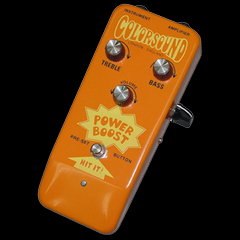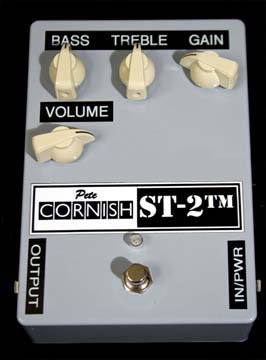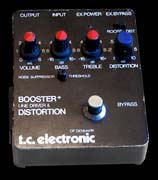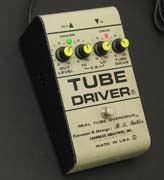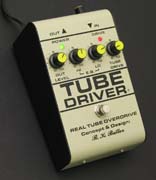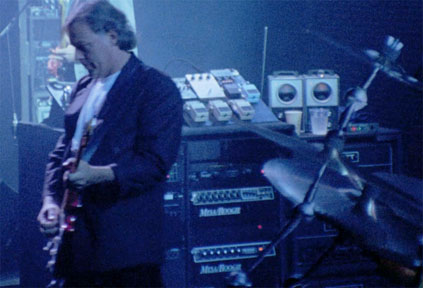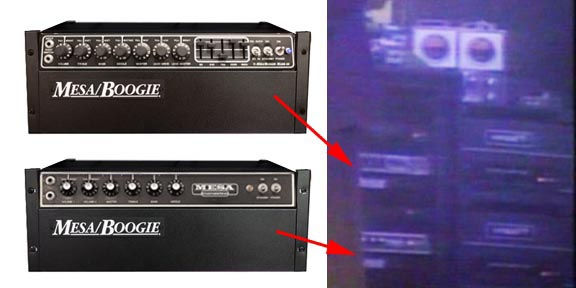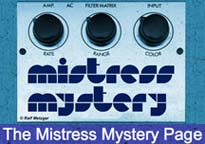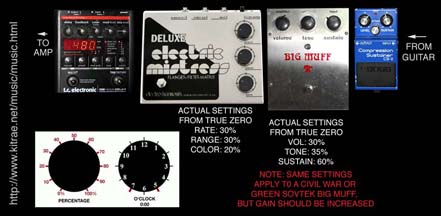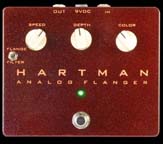NOTE: This website is frequently updated. Last update September 2022.
Big Muffs like to be driven hard and I think they sound best through a loud, clean tube amp. A Tube Driver, or similar overdrive pedal, can be used as a light boost before or after a Big Muff in the signal chain. I am not referring to a volume boost, but rather a blend of the gain and tone from the two different pedals, which can slightly smooth out the distortion, add sustain, or EQ the Big Muff signal. This is also known as 'stacking'. Whatever you want to call it - boosting, driving, blending, or stacking a Big Muff with an overdrive pedal can sometimes make the Big Muff tone come alive and help it cut through in a band mix. Depending on the stacking order and the type of overdrive, it can smooth out the fizzy harshness of the tone while adding some gain, or add more dirt and grit to the tone. While it is not necessary for a good David Gilmour tone, some modern Big Muffs and some vintage Muffs can benefit from this type of boost.
It is unknown if or when Gilmour used a booster for his Big Muffs in the studio, but he certainly did use them live during the 1980s, the 1987-89 Momentary Lapse of Reason tour, the 1994 Division Bell tour, and the 2006 On an Island tour. He probably did this as far back as Pink Floyd's 1977 Animals tour. Both his backline tech, Phil Taylor, and pedalboard builder, Pete Cornish, have noted that David likes to drive his Big Muffs into a booster pedal, and Gilmour himself even listed his own pedal chain settings (in the July 1995 issue of guitarist) for the Division Bell tour, combining the BKB Tube Driver with the Big Muff for solos. Based on David's effect settings and his tone, the boost effect as David used it was typically very subtle. It is definitely not necessary or required to get his Big Muff tones.
"David doesn't necessarily use anything exactly as it is, or as you would expect. There are times when he has run a Big Muff into various things such as a Boogie head or a BK Butler Tube Driver, or added a graphic equalizer,etc" - Phil Taylor, David Gilmour's gear tech, 2009 Guitar Player
It is debatable, but David Gilmour may have used his Colosound Power Boost to blend with his Fuzz Face and his Ram's Head Big Muff in the late 1970s. The distortion tone David used during the 1977 Animals/In the Flesh tour, and on the 1978 Columbia Records promotional videos David made for his first solo record, and possibly on the record itself, sound like a Big Muff with the Power Boost placed after it in the signal chain. The dry treble and fuzz from the Power Boost are very distinct. David also had a Pete Cornish ST-2 (a modified Power Boost type circuit) around 1978 which he may have blended with his Big Muffs. In the 1980s he used a Mesa/Boogie head as an overdrive in his signal chain to blend with a Boss HM-2, and with the HM-2 or Big Muff in Pink Floyd's 1987-1989 Momentary Lapse of Reason tour rig. In 1990 he used a Cornish P-2 instead of the Big Muff to blend with the Mesa/Boogie overdrive.
He changed to a B.K. Butler Tube Driver for his 1994 Division Bell tour pedal arsenal, which he used to blend with his Sovtek "Civil War" Big Muff, the Cornish P-2, and as a light overdrive pedal. I have the signal chains for every song HERE, so you can see how the TD was blended with the high gain effects and the chain order. For the 2006 David Gilmour tour he used two new B.K. Butler 911 Tube Drivers in his board. One was used as a low gain Big Muff blender, and one for overdrive. See my Tube Driver page HERE for more info about using one.
(above) Colorsound Power Boost, Cornish ST-2, TC BLD, 1980s Butler/Chandler Tube Driver, 911 Butler Tube Driver
(above) Mesa/Boogie Mark III and Mark II amp heads used as overdrives in David's signal chain in 1988, blended with the Big Muff and Boss distortions
SIGNAL CHAIN ORDER - Gilmour has placed overdrives both before and after his Big Muffs. In his early days with Pink Floyd he started with the Colorsound Power boost before the Fuzz Face, and the PB was likely an "alwasy on" pedal, set for a light drive setting.
In David's custom 1976 pedal board, made by Pete Cornish, the Power Boost came after the Fuzz Face and Pete Cornish custom Big Muff in the signal chain, but it came before the send/return jacks with David's 1974 Ram's Head Big Muff and Electric Mistress in a loop. David's sound for Pink Floyd's 1977 tour was very unique and aggressive, and almost all his tones have the voice and flavor of the Power Boost. Most of the light and heavy overdrive was simply the Power Boost with the drive set to maximum, with the guitar volume knob used to set the amount of drive. David's extreme high gain sounds cannot be achieved by the Power Boost, Fuzz Face, or Big Muff alone though. I think he had to be stacking the PB with one of the fuzz pedals. In trying all the various combinations of those pedals, I found the best combos are running the Big Muff into the Power Boost or the Power Boost into the Big Muff. However, the PB into the Big Muff nails those those tones in my rig, and I think is what I David actually did. I also think it sounds best if the guitar goes direct to the Power Boost, with no buffer in between.
Guitar > Power Boost set for maximum drive > Ram's Head Big Muff with sustain set very low > Electric Mistress > Delay
When that Cornish pedal board was revised in 1979, the Fuzz Face and Muff were both placed before the Power Boost in the chain, and David's lead tones changed, leading me to believe that the PB+Big Muff combo was probably unique to the '77 tour, and not used after. Some evidence for that is the small Pete Cornish boards David used for the second half of The Wall concerts in 1980-81. They had a Big Muff built into them, but no Power Boost.
For Pink Floyd's 1987-1989 tour the Big Muff ran into his Mesa-Boogie, used as an overdrive in his signal chain. He did the same for the Knebworth concert in 1990, confirmed by the signal chain router seen in the concert video.
When David used his Tube Driver + Muff combination for Pink Floyd's 1994 tour (heard on Pulse), the TD nearly always came first in the signal chain before the muff. That was confirmed by the signal chain router seen in multiple concerts. The only time it came after the Big Muff (or P-2) was for the Time solo, but I think that was only because he wanted more drive to push the signal through his Uni-Vibe.
For David's 2006 On an Island tour, the Tube Drivers came after the P-1 and G-2 in the signal chain, but we do not know if he ever used them together. Gilmour's gear tech, Phil Taylor, said David mostly used his Tube Drivers on that tour, not the Cornish Big Muff. Even for Comfortably Numb.
He did not blend Tube Drivers with the muffs at all for his 2015/16 Rattle That Lock tour. That was confirmed by the signal chain router seen in multiple concerts.
Below are Tube Driver + Big Muff sound clips demonstrating the difference between a Tube Driver placed before a Big Muff and Tube Driver after a Big Muff in the signal chain. The TD and Muff settings were identical in each clip. The TD after the muff sounds more overdriven and on the edge of breakup than the one before, but the settings on each pedal can be changed to sound like the opposite.
![]() Tube Driver before Sovtek Big Muff
Tube Driver before Sovtek Big Muff
![]() Tube Driver after Sovtek Big Muff
Tube Driver after Sovtek Big Muff
THE GILMOUR TUBE DRIVER BOOST SETUP - Based on David's 1994 Division Bell tour signal chain and effect settings, his On an Island tour settings, and listening to the official recordings and bootlegs, he used the Tube Driver to blend with the Big Muff. The purpose was NOT for a volume boost - it was simply to blend the two pedals into one for a more pleasing and effective Big Muff lead tone. This combo tames the Big Muff distortion ever so slightly to reduce the buzziness and refine the crunch of the attack, along with a little EQ tone altering. It is a very subtle effect, and the mistake I see most people making is setting the gain of the booster pedal too high and making the Big Muff sound like a noisy, farty, muffled mess. When David did this in 1994, it only affected the tone of his Big Muffs in a minor way.
Here are instructions to set up the Big Muff/Tube Driver combo heard on David's 2006 solo tour, as captured on the Remember That Night DVD and Live in Gdansk. Note that these settings are for a Strat with a hot single coil bridge pickup, through a loud, clean tube amplifier. David's settings make make the Big Muff right on the edge of choking. He used a Pete Cornish P-1, which is a very good Ram's Head era Big Muff clone, into a 2005 BK Butler 911 Tube Driver. If you have a 1990s Real Tube 911 Tube Driver or a BKB 911 Tube Driver made since 2006 you will notice when you turn the knobs you can feel the pot notches click by.
1. Set both Big Muff and Tube Driver knobs to David's OAI settings (they are posted here), with the TD following the Big Muff (Cornish P-1). Set the TD drive pot exactly three notches from zero (the ones you feel when turning the knob, not the notches printed on the pedal).
2. Turn the Big Muff on, guitar volume at 10, and listen. That is your unity volume.
3. Keep the Big Muff on and switch your TD on. If the unity volume goes down, adjust your TD volume until there is no difference in volume with the TD on or off. Some people may like the volume to boost a bit when they hit the TD, but for now keep them the same.
4. The Big Muff should be right on the edge of breakup. Turn the TD drive pot down one notch and listen for your unity to drop. If it does not drop, turn the drive down another notch. Whatever notch position brings the unity down, you want to be one notch above that. That should give you the exact gain saturation that David had for the OAI tour. One notch too low and the unity drops, one notch too to high and there will be a slight volume boost and too much breakup, but there SHOULD be some signal breakup. It is literally that fine of a line with the 2006 BKB TD. You just want to determine what level of breakup you can handle. You don't want the low strings crapping out and choking on you, but they should choke a bit. This setup works for The Wall Big Muff tones too.
If it breaks up too much for you, back the Big Muff sustain down slightly, and bring the tone up the same amount (the muff tone and sustain circuits are interactive). Find the balance you like in this manner, but if you can't handle that Big Muff breakup through your guitar and amp, then don't boost. This is not a tone that is handed to you, you have to work it out with your fingers, but this is the setup. Note that the instructions above do not work for the 1980s era BKB/Chandler Tube Drivers since those circuit were slightly different, so the drive pot positions may be different.
OTHER WAYS TO BOOST - What the boost does really depends on the settings of the booster pedal and the Muff and where the booster is placed in the chain, before or after the Muff. Putting most drivers after the Muff seems to be a bit smoother, and before the Muff usually has more crunch and attack, but some boosters do the opposite. You can get harsh top end, smooth top end, boomy lows, light lows, or whatever you want, especially if the booster has a tone control, or better, both a bass and treble control. Also which pedal is "driving" which has an effect on the tone - meaning which has the high gain and which the low. The Muff sustain can be set high and the drive on the booster pedal low, or vise versa. Each yields a slightly different tone. Set the booster pedal's bass and treble or tone knob to be as transparent as possible, in that the clean tone is not colored when the booster is switched on. I suggest starting with the booster placed after the Big Muff. Set the Big Muff sustain and booster drive both at 50%. Then adjust the Muff sustain up, booster drive down until you get the tone you want. You may also want to try it the other way around, with the drive pedal having the high gain and the Muff low gain. If the sound craps out and sounds farty, or drops out when playing the low E string, there is too much gain from one pedal or the other causing the signal to overload and break up. Experiment with the gain/drive of each pedal until you have a sound that is almost to the point of breaking up. If you can't find a suitable sound with the booster placed after the Big Muff, try the procedure again with the boost in front of the Muff. Keep in mind, some vintage and boutique Big Muffs sound so good at high gain that you may not see much improvement by boosting.
I typically use my Tube Driver to drive the gain of the Big Muff. It creates a very subtle difference to the Big Muff tone. My Muffs are usually set to around 65-70% sustain and my Tube Driver (BKB/Chandler version) set to around 10% drive. The bass and treble controls of the Tube Driver are set to be very similar to the Muff tone, so when switching it on or off, there is very little change to my Muff's tone color. On the other hand, I use the Colorsound Overdriver to color the tone of my Big Muffs by placing it after the Muff in the signal chain, so the Overdriver circuit alters the tone and gain of the Big Muff signal entering it. I also like to use a Boss CS-2 or MXR Dynacomp for light compression before a Muff to sharpen the clarity and attack of the notes, but adding these to a boosted Muff also adds more noise from the gain stacking up from all of these pedals.
I have tested using Tube Screamers, the Boss BD-2 Blues Driver, the Colorsound Overdriver, Colorsound clones like the Color Drive, various Tube Driver models, and a variety of other overdrive pedals for boosting Big Muffs. My favorites are the SMS Earth Drive, BD-2, BK Butler four knob Tube Drivers, and the Colorsound Overdriver. Each has a unique effect on the Big Muff gain and tone. I never had much luck getting a sound I liked when using a Tubescreamer type pedal to boost, simply because they were too bright and hollow sounding, and drastically altered the tone of the Big Muff in a way that did not suit my tastes. The best boosters are the ones that are transparent sounding, so as to not alter the tone of your Big Muff or Muff clone too much, or the ones that offer a pleasing mix of the two tones.
BOOSTED BIG MUFF VS. BIG MUFF WITH HIGH SUSTAIN - Below are some old sound clips form a previous version of this page. They do not necessarily represent an accurate Gilmour tone, but these sound clips help illustrate the difference between the sound of a Big Muff with the sustain set rather high vs. a Big Muff with the sustain at 40% and a boost Tube Driver placed after the Big Muf to add gain and smooth out the tone. As you can hear, the boosted Big Muff has a slightly smoother tone. Strat with Seymour Duncan SSL-5 bridge pickup into a Reeves Custom 50 (Hiwatt clone) with Vintage Purple (Fane clone) speakers.
OVERDRIVE BOOST
SMOOTH BOOST
BOOST POSITION IN SIGNAL CHAIN - Driving the Big Muff with the booster pedal and driving the booster pedal with the Big Muff
MY FAVORITE BOOST/BLEND SETUPS
Boss HM-2 into Big Muff - The HM-2 is an excellent booster into a Big Muff for Delicate Sound of Thunder lead tones. Place the HM-2 before the Muff (Ram's Head style or Sovtek style) in the signal chain. Set the HM-2 L color knob about 70-75%, the H color around 60%, and drive 50%. The HM-2 is the driver and the muff is the EQ in this combo, so the muff sustain needs to be set very low, around 20%. The muff tone circuit is interactive with the sustain, so as you turn turn the sustain down, turn the tone up the same amount (treble side). I kept mine about 80%, but adjust until it sounds right on your amp. It sounds incredible into a clean Fender amp, but unfortunately sounds thin and crappy into a Hiwatt.
Tube Driver - Placed before the Muff in signal chain. Hi EQ at 4, lo EQ at 6, drive at approximately 1 to 1.5
Muff sustain at about 65-70%, tone about 35%, or whatever tone setting works on your rig in the Gilmour range.Colorsound Overdriver - Placed after the Muff in signal chain. Treble at 70%, bass at 40%, drive at 90-95%
Muff sustain at about 30-35%, tone about 35%, or whatever tone setting works on your rig in the Gilmour range.Boss BD-2 Blues Driver - Placed after the Big Muff in the signal chain for a super smooth boost, almost to the point of breakup. BD-2 Tone at 70% (2:00), gain at 20% (9:00).
Muff sustain at about 40% (11:00), tone about 35%, or whatever tone setting works on your rig in the Gilmour range.
The Electro-Harmonix Electric Mistress flanger is a signature part of David Gilmour's liquidy modulated tones from The Wall and The Final Cut era, as well as David's first solo album. It is also heard during the In The Flesh tour for the 1977 Animals album, and was used heavily in The Wall live shows. The Mistress is unique among flangers, and no other flanger sounds quite like it. At the right settings it sounds like a very deep chorus, other settings can sound like a mix of the swirl of a Univibe mixed with a Phaser, or the common "jet" sound (not a sound associated with Gilmour). The Mistress also sounds very good when used with a vintage Electro-Harmonix Big Muff. The two circuits seem to work hand in hand, creating a very mean, but liquidy smooth distortion tone. Add some warm analog or digital delay to that and you have classic Gilmour. David used the Mistress in a similar way to how he used the Univibe, rotating speaker cabinets like the Leslie and Yamaha RA-200, and the Boss CE-2 - to add a swirly modulation to his guitar tone and add to the feeling of space and depth.
David's first Electric Mistress was old green 18v version from around 1976. These sound slightly different than the later Deluxe Electric Mistress, but both create a very similar flanged modulation. The old green Mistress, or a clone like the Hartman Flanger, are more accurate for this early Gilmour tone than the Deluxe version. The Deluxe is a bit too swirly and dominant, though some may prefer it to the older one. The later Stereo Electric Mistress is a very different sound to both earlier Mistress circuits, more like a chorus. I don't recommend it, but it can work as a substitute.
Many people seem to think all of David's modulated lead tones from Animals, the David Gilmour solo album, The Wall, and The Final Cut are the Electric Mistress. You may be disappointed when you try getting these tones with the Mistress and a Big Muff. The modulation most used on those recordings was the Yamaha RA-200 rotary speaker cabinet. I hear the Mistress on a few solos from Gilmour's first solo record, The Young Lust solos and a few other places on The Wall, and it works for the clean chorus sounding tones. Other places it sounds like the RA-200 or a blend of the RA-200 and Mistress. The RA-200 modulation is similar, but much warmer and less metallic sounding.
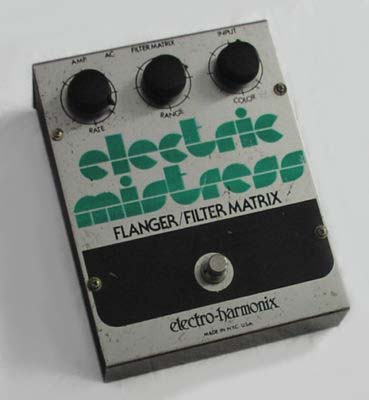
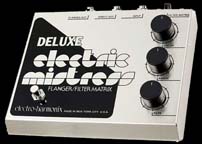
Vintage Electro-Harmonix 18v green Electic Mistress flanger used by David Gilmour in the 1970s and early 1980s, and the Deluxe Electric Mistress that replaced it
Visit Ralf Metzger's Mistress Mystery Page for information on all versions of the Electric Mistress and Deluxe Electric Mistress
VINTAGE GREEN ELECTRIC MISTRESS - Here are sound clip using a vintage violet "Ram's Head" Big Muff and a vintage 18v green Electric Mistress. Stratocaster with Seymour Duncan SSL-5 bridge pickup into a Fender Twin Reverb and Reeves Custom 50PS (Hiwatt replica).
Final Cut solo - Original David Gilmour The Final Cut solo studio recording
Young Lust solo , no Mistress - For reference with "Ram's Head" Big Muff only
Young Lust solo, with Mistress - "Ram's Head" Big Muff with vintage 18v Green Electric Mistress
DELUXE ELECTRIC MISTRESS - Here are sound clips using a vintage "Ram's Head" Big Muff, the Deluxe Electric Mistress. Stratocaster with Seymour Duncan SSL-5 bridge pickup into a Fender Twin Reverb. The Mistress is mixed into Big Muff signal about 75% using a blend pedal. Pedal settings are shown above.
Final Cut solo - Original David Gilmour The Final Cut solo studio recording
Shine on Blues demo with Ram's Head Big Muff and Deluxe Electric Mistress - backing track is based on the Shine on You Crazy Daimond chords and can be found at Gilmourish.com. It's a great blues track to jam too.
HARTMAN FLANGER - Here is a sound clip using a Hartman Flanger, a high quality replica of the old green Electric Mistress (non deluxe). It sounds nearly identical to my green Electric Mistress. Compare this Mistress sound to the sound from the Final Cut studio recording, which I beleieve to be the Yamaha RA-200 rotary speaker cabinet powered by an Alembic F-2B preamp (a Fender Twin premap clone) and the Hiwatt DR103 with WEM Super Starfinder cab. This is the same setup from The Wall. The Mistress modulation is very similar to the rotary speaker/Hiwatt cobo, though not quite as smooth and warm. Strat with Seymour Duncan SSL-5 bridge pickup into a Reeves Custom 50. Mistress mixed into Bug Muff signal about 75%. Backing track can be found at Gilmourish.com.
Final Cut solo - '73 Ram's Head Big Muff replica from Stomp Under Foot and Hartman Flanger
WHY CAN'T I GET MY ELECTRIC MISTRESS TO SOUND LIKE GILMOUR? - Many times when people think they are hearing the Electric Mistress they are actually hearing David recording with rotating speaker cabinets like the Leslie and Yamaha RA-200. That is the case with the many of the Animals solos, the Comfortably Numb solos, and the Final Cut solo. The Mistress is a close approximation however, and even David used one in place of the rotary speaker cabs when playing live. When I listen to The Wall and the Final Cut, I do not hear this type of modulation mixed into the tone of the Big Muff solos 100%. It is much too dominant for most of those tones for my taste. In fact, I don't hear the Mistress 100% in much at all from that era. Sure there are a few exceptions here and there, like some of the solos on David's first solo album, and the original Wall concerts, but overall I believe David always blended the Mistress. Based on all the interview comments from David and his recording/engineering crew over the years, and listening to the 5.1 mixes, David typically recorded through more than one amp or speaker cabinet, then fine tuned the level of the modulated and unmodulated tracks, or even delayed and non delayed guitar in the final mix. Comfortably Numb is one example of this. For clean tones it is not a problem using the Mistress full on, but a blend pedal is almost a necessity with the Mistress for when using any distortion, in my opinion. My Mistress is never more than 50-75% in the mix. If you start with your Mistress at 50% in the mix, then adjust the knobs for the correct modulation, you will find you get much closer to those recorded modulations you hear in many of the studio tracks than 100% in the mix. I use a Barge VB Jr. blend pedal to mix in the signal from my modulation pedals in a bypass loop with my distortion signal. The Boss LS-2 is another pedal that features the blend function, but there are many others.
More Electric Mistress clips and information on David's modulated tone can be found on this page
Kit’s Secret Guitar, Gear, and Music Page
Guitar stuff, gear stuff, soundclips, videos, Gilmour/Pink Floyd stuff, photos and other goodies.
Copyright Kit Rae.
VISIT MY SWORDS, KNIVES and FANTASY ART WEBSITE www.kitrae.net

